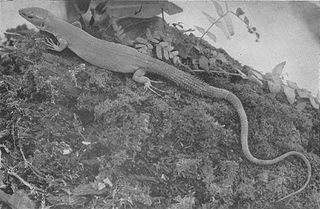
Gastropholis is a genus of Equatorial African lacertid lizards of the family Lacertidae which is distributed in southern Liberia, Ivory Coast and Ghana, western Cameroon, Equatorial Guinea, Democratic Republic of Congo, eastern Kenya, Tanzania and south to northeastern Mozambique.

Holaspis is a genus of equatorial African lizards in the family Lacertidae. These lizards are capable of gliding flight for distances of 30 meters.

Anadia is a genus of lizards in the family Gymnophthalmidae. The genus is endemic to southern Central America and northern South America.

Threatened fauna of Australia are those species and subspecies of birds, fish, frogs, insects, mammals, molluscs, crustaceans, and reptiles to be found in Australia that are in danger of becoming extinct. This article lists species classified as threatened species under the Commonwealth Environment Protection and Biodiversity Conservation Act 1999.

The greater grison is a species of mustelid native to Southern Mexico, Central America, and South America.

Pteris vittata, the Chinese brake, Chinese ladder brake, or simply ladder brake, is a fern species in the Pteridoideae subfamily of the Pteridaceae. It is indigenous to Asia, southern Europe, tropical Africa, and Australia. The type specimen was collected in China by Pehr Osbeck.

The Eastern Congolian swamp forests are a fairly intact but underresearched ecoregion of the tropical and subtropical moist broadleaf forests biome. It is located within the Democratic Republic of the Congo. This is the eastern half of one of the largest areas of swamps in the world.

Congolacerta is a genus of equatorial African lacertids of the family Lacertidae. Species of this genus are distributed in western East Africa.

Dasia vittata, the Borneo skink or striped tree skink, is a species of lizard endemic to Borneo. It is oviparous and arboreal.

Cyrtopodion gastrophole, also known commonly as the Farsian spider gecko, Werner's spider gecko, or Werner's bent-toed gecko, is a species of gecko, a lizard in the family Gekkonidae. The species is endemic to southcentral Iran.

Gastropholis prasina, the green keel-bellied lizard, is a species of lizard belonging to the family Lacertidae.

Gastropholis echinata is a species of lizard found in Liberia, Ivory Coast, Ghana, Cameroon, Equatorial Guinea, Gabon, and the Democratic Republic of the Congo.

Holaspis guentheri, also commonly known as the neon blue-tailed tree lizard, the sawtail lizard, and the western neon blue-tailed tree lizard is a species of lizard in the family Lacertidae. The species is native to portions of West Africa and Central Africa.
Contomastix vittata is a species of teiid lizard endemic to Bolivia.
Anadia vittata, Boulenger's anadia, is a species of lizard in the family Gymnophthalmidae. It is found in Panama and Colombia.












